
The following is part of Now Loading, a series that renders verdicts on whether or not your favorite video games deserve a place in the canon of works that have contributed to video-game storytelling in landmark ways. Read the series’ full mission statement here.
A Lovable, Complicated Mess
Ladies and gentlemen, boys and galpals, welcome to this installment of Now Loading…The Video Game Canon! The only weekly column on the Internet that looks at games from the past to decide whether or not they are worthy of being remembered for all time. It can be a harrowing experience from time to time, but trust me when I say that, ultimately, it is a pleasure to look back on these old games with a critical eye. In some cases, this series is simply a way to play an older video game and assess it based on how it contributed to the art of video games as a whole. And yet in other cases, it’s an excuse for me to put on my rose-tinted glasses, pop in a game full of memories from my childhood, and then run that game through a gauntlet of rigorous and unrelenting analysis that is not always kind to these nostalgic little gems from the past. Canonization is dirty work from time to time, but damn it, even the shiniest beacons of childhood wonder need to be taken with a grain of salt from time to time. Having said all that, let’s dive into The Legend of Dragoon.
Developed by SCE Japan studio and published for the Sony PlayStation at the turn of the millennium, The Legend of Dragoon is a prime example of a game that spends a great deal of time (four whole discs, in this case) establishing a complex and interesting universe rich with lore, history, and a complicated set of fantasy rules that it follows to the letter. Just as with any all-encompassing fantasy universe like those of Game of Thrones and The Lord of the Rings, The Legend of Dragoon establishes a world so detailed that anyone engaging with the story truly feels as if they have become a character living there. In this way, The Legend of Dragoon is very similar to the first game we examined for the canon, Final Fantasy VII. Through striking visual environments, memorable character designs, and an expansive world map to explore, both games present the player with worlds in which you can very easily lose yourself. However, unlike how Final Fantasy VII’s gigantic world allows for the player to overlook some of the nonsensical plot inconsistencies, The Legend of Dragoon has nearly the opposite problem: it presents the player with so much backstory, history, and complex plot that the world in which it takes place becomes a cloying, overwhelming place.
Now, at this point, if you’ve been kind enough to have read the previous entries into this series, you may be asking yourself why “too much plot” is an issue when it comes to video game storytelling. “After all,” you say timidly from behind your knitting, “didn’t Fallout 3 suffer from the lack of world-building that comes from not having enough of a plot?” Well, the issue with video games, dear reader, is that they walk that tightrope of a line between building a rich world that lures the player into playing the game, and presenting just enough information so that the player says, “I want to know what happens next.” If a video game overloads the player with too much fantasy jargon too early, average players will feel fatigued by all that trivia and simply walk away from the story. You can have those complicated story beats with all those fantasy terms, but you have to earn them, later on in the story, by drawing the player in and keeping them invested early on in the story.
Take a game series that we will no doubt come to in the near future: Kingdom Hearts. Put simply, the story and world in Kingdom Hearts are straight-up bananas. If you have kept up with that series for the past few years, you have encountered the following:
- the concept of nothingness
- what it means to have no emotions
- body-swapping storylines
- characters that both literally and figuratively house multiple consciousnesses inside their minds and bodies
- an ever-expanding mythos around swords that are keys
- the most confusing explanation of time travel ever devised by any human being, living or dead
And yet, most fans of the series accept these fantastical additions to the story because the first game was so simply and beautifully crafted. The first Kingdom Hearts game, at its core, was a barebones story of light vs. dark and good vs. evil. The series gradually built up to the craziness that it is today, and, whether you like it or not, it’s hard to argue that 15 years and nearly as many games didn’t earn it a little wackiness.
But what happens when a game developer tries to cram all that build-up and fantasy wackiness over the course of one game? What happens when a story spread across multiple discs tries to accomplish the momentous task of keeping the player invested while at the same time establishing a fantasy universe on nearly Tolkienian orders of magnitude? Well, you end up with The Legend of Dragoon.
Let’s take a look, shall we?
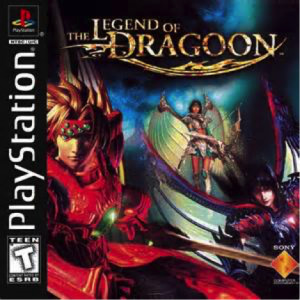
Story and Characters: Go for the Bullseye, Dart
Looking back once again to the entry we had on Final Fantasy VII, you may remember my brilliantly hilarious retelling of the complex plot of that game. No doubt you will recall that the recap was so funny that it shot into the stratosphere of public opinion and changed the very face of comedy as we know it forever; but you may also recall that I basically made the point that Final Fantasy VII is a story with brilliantly executed themes, wrapped up in a complex and sometimes nonsensical plot package.
The Legend of Dragoon is very similar in that regard, except that I am hard-pressed to think of any life-changing themes that the game presents. The game uses what I would call the “Japanese Role-Playing Game template”: you start out small with a few likable characters and gradually zoom out more and more until the very universe is at stake, and only you and your band of misfit heroes are able to save it. It’s a tried-and-true way to tell a video game story, and for the most part The Legend of Dragoon does it well. The characters are all well defined and well written, and there are just enough good twists and turns in their interpersonal relationships that by the end of the game, you feel as if you’ve interacted with fleshed-out, real characters. Unfortunately, the story is at once very simple and incredibly complicated, so your focus is taken away from the characters all too often.
The story, in a nutshell, is your basic JRPG “save the world” story. We begin with our main character, Dart, returning to his hometown after a five-year journey hunting a beast known as “The Black Monster.” The Monster killed his parents and destroyed his birth town, so as soon as Dart was old enough to hold a sword as big as his grudge, he left his home and childhood friend Shana in pursuit of the creature that killed his family. On his way home, he is chased and nearly killed by a giant green dragon, but is saved by the character Rose, who informs Dart that the dragon is being used by one of the sides in a massive civil war to destroy the other side. As it happens, the dragon had just gotten back from attacking Dart’s home town, so he rushes away from Rose only to find that his hometown of Seles has been completely decimated. And what’s worse, Shana has been kidnapped by the imperial forces who wrecked the town.
So, at this point we have a brilliant ante into the world of Dragoon. We have our main character, who is oblivious to the civil war going on near his home because he has been on a revenge quest for five years. We have a dragon who is being controlled by the evil imperial forces, and a woman, Rose, who clearly knows more than she is letting on. Finally, we have a very personal reason for Dart to implicate himself into the civil war and align himself against the empire: they have kidnapped his childhood friend and love interest for mysterious, nefarious purposes. This is a brilliant introduction not only to the world of the game, but also to the character as whom we will be playing throughout the whole story.
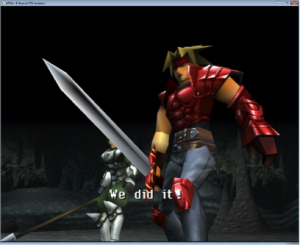
For the time being, pal.
I wish I could tell you that the momentum from the opening sequence continues throughout the rest of the game, but we have nearly four discs left to cover and we don’t even get to the word “Dragoon” until halfway through this first disc. What follows is an incredibly complex and layered plot that consists of Dart rescuing Shana, making new friends and building his party, and confronting a mysterious hooded figure named Lavitz who has vague, evil motivations we will not even become close to privy to until the beginning of the second disc, after his death. Things move along both quickly and slowly in this game: the player is expected to pick up on all the complexities, and just move on when the story asks him to.
Once it is revealed that Dart and his friends house the spirits of ancient warriors known as “Dragoons” who could control dragons and harness their energy, the game gradually reveals that thousands and thousands of years ago, there was a conflict between the Dragoons and an angelic, elven race of people called the “Winglies.”
Yes, really.
The Winglies believed that might made right, and that those with power were given divine right to rule over those who could not easily fight back. The Dragoons, eternal champions of free will and justice, used the power of the dragons to fight the oppressive Wingly regime. Just as the war was coming to a dire close, the leader of the Winglies, the inexplicably named Melbu Frahma, unleashed the power of something called the “Virage Embryo,” which was more or less the ultimate God of Destruction. The Dragoons were able to stop the Virage Embyro by splitting its body and soul, which resulted in the lifeless body becoming a moon that never sets in the sky, and the soul being reborn every one-hundred-and-eight years into the body of some poor, unsuspecting human.
With me so far?
Well, it turns out that Rose, that woman from the beginning of the game, and Dart’s father, Zieg (also a Dragoon) swore to remain living until the soul of the Virage Embryo was destroyed, meaning that it could never reconstitute itself and bring about the apocalypse. Melbu Frahma, that cheeky Wingly, got wind of this plan and essentially possessed the body of Zieg, and then posed as the emperor Diaz who ruled over the empire for God-knows-how-long. Rose, meanwhile, roamed the world for millennia looking for the Virage Embryo soul as—surprise surprise—The Black Monster. That’s right, Rose killed Dart’s mother, but not his father, because actually his father is a millennia-old dragon man with the soul of medieval-angel Voldemort hanging out inside him. Melbu Frahma eventually does use Shana to reconstitute the Virage Embryo, but is able to put his own soul inside the dead husk so that he effectively becomes the God of Destruction. Dart and the gang do their thing and take him out, and we end on Dart and Shana rebuilding Seles as the world experiences Wingly/Dragoon free peace.
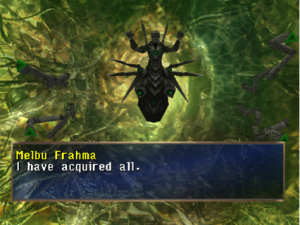
I have strong disagreements.
I have pared that story down as much as I could so that it would fit into this finite article, but believe me when I say there are more wild fantasy names, terms, and events that happen throughout this massive game. In so many ways, the plot of this game is similar to Final Fantasy VII’s:
- there are characters with intense amnesia
- one of your main party members dies at the end of the first disc
- the plot of the villain is essentially to become a God
Unfortunately, though, there are just as many plotlines that go nowhere, make little-to-no sense, and end up genuinely confusing the player as they make their way through the many medieval towns and areas in the game. If the game had been paced as well as its opening sequence, then it would have provided for a really interesting story that kept you hooked at every turn. Unfortunately, the wide scope that the writers tried to establish was so dense and packed with detailed world-building ideas that the player gets bogged down in the minutia, and when the ultimate villain and his plot is revealed, it seems like less of a satisfying twist and more of a “wait, what?” moment because of how much crucial plot the player may have missed.
When it comes to characters, the only three that really stand out are the three that I have mentioned: Dart, Shana, and Rose. It seems that these three were given the most interesting characterization because of their ultimate importance to the plot, but even despite that, it feels like Dart and Shana (as well as all the other characters who eventually join your party) are incidental spectators in a story that had nearly reached its conclusion thousands of years prior to the time in which the game takes place. When you break it down, the story is less about Dart and Shana and more about Rose and Zieg, two characters whose motivations we don’t truly understand until almost the very end of the story. The people we should care about are so often put on the back burner, and the game tries instead to invest you into the sprawling story it presents. Sadly, it fails to do so, so our characters are often left by the wayside as a consequence.
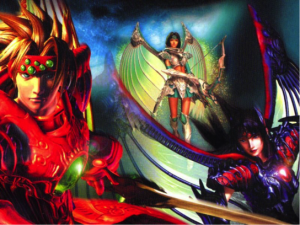
Gameplay, music, and visuals: BURNING RUSH!
What this game lacks in story and characters, it more than makes up for in all three of this section’s qualities. As it is a JRPG, the bulk of the gameplay revolves around your characters’ stats and the combat system. Where this game really shines, however, is in the quick-time elements that are added to the turn-based battles.
While most games don’t get points for including quick-time events that require you to press certain buttons at certain times to progress the game, Legend of Dragoon implements them perfectly in its combat system. You have your standard attacks and your items, of course, but you are also given the option to give them a boost in damage by timing certain button-presses to increase the amount of combos you perform. For example, while attacking you are prompted with precise button-presses to elongate your attack, such that, by the end of the game, you can have a single combo attack that hits the enemy between eight and twenty times in some cases.
Unlike other role-playing games in which you just naturally perform longer combos as you level up, Legend of Dragoon makes you earn those better combos by hitting the button at the precisely correct moment. In some cases, failing to do so will actually result in a penalty to your character, which can at best leave the enemy unharmed, and at worst leave you with recoil damage. It’s a fascinating mechanic that adds an level of active play to a traditionally inactive system of combat.
This is only further explored later in the game when your characters get their Dragoon Spirits, which are items that allow them to transform into armor-clad Dragoons with the power of dragons imbued into their weapons. To use your Dragoon form, you need only build up a gauge over the course of different fights and then release it in battle. With this form, you are given even more combo attack opportunities, as well as the ability to use powerful, element-based magic attacks. The Dragoon form not only lets the player feel how powerful Dragoons are in this world, but also makes for much more interesting boss encounters towards the end of the game.
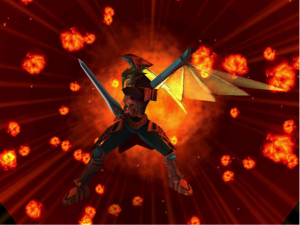
Pictured: Just, the coolest thing.
The soundtrack was composed by Dennis Martin and Takeo Miratsu, and is a perfect blend of traditional, medieval-type instrumental music and late-nineties guitar riffs. This may sound like an odd combination at first, but the strange mixture of synthesized video game music and blasty metal riffs make the entire game sound the way that a fantastical heavy metal album cover looks. There is a wide music library of over one hundred tracks, and each of them fits the scene to which they are assigned beautifully.
Lastly, the visuals in this game are the best that the PlayStation had to offer at the turn of the century. The characters are rendered well both in and out of battle animations, and the pre-rendered backgrounds are on par with anything from a later Final Fantasy title for the PS1. There are also a number of little visual flourishes that add to the overall feel of the game, like how your character moves through the points on the overworld map as if they were charting a high-seas adventure course, or how in all the wilderness areas you can see small animals going about their business in the backgrounds. Little touches like these, coupled with the overall quality of the environments, makes the world of Dragoon feel that much more lived-in.
Impact on Video Gaming and Culture: A Huge American Hit
This section is really where we come to the nitty-gritty of it all, and see why this game is ultimately so problematic. If you were to research this game, you may be surprised to discover that it was quantifiably about four times as big a hit in North America as it was in Japan. Clocking in at a minuscule 280,000 units sold in Japan and just under a million copies in America (as of the end of 2007), it is no doubt that The Legend of Dragoon found a much nicer home in the States than it did in the country that created it.
The reason for this, I think, can be chalked up simply to role-playing-game fatigue in Japan and a thirst for Final Fantasy VII-esque games in America. Like I mentioned in the first article of this series, there was perhaps no bigger explosion of popularity for a genre than when VII reached American shelves. Sure, there was appreciation for Japanese role-playing games before that, but they were never even close to the rockstar status that Final Fantasy VII granted them. That game opened up so many doors for so many RPG players both old and new, so when a game came out in mid-2000 boasting similar graphics, four discs, and the promise of a story that was just as epic, people leapt at the chance to buy and play The Legend of Dragoon.
Though a beneficiary of this RPG craze and the recipient of some fairly favorable reviews, The Legend of Dragoon lacked a certain staying power that other RPG series of the time had. Not only that, but the developer had put so much work into making the world so immense and immersive that it seemed all but a foregone conclusion that there would be many sequels to follow it. However, due to less-than-stellar sales in its home country of Japan and the release of the much more sophisticated PS2 on the horizon, talks of a sequel soon stopped and faded away completely. The closest we ever received to a The Legend of Dragoon 2 was the release of the game on the Playstation Network Store just a few years ago, and while its status as a cult favorite boosted those sales by a bit, it clearly wasn’t enough for Sony to entertain the idea of bringing this franchise back in any way.
The Legend of Dragoon seemed to have everything going for it to become the next big franchise, but due to poor sales and a story that was too chock full of content too soon, this little gem from the PS1 era was relegated to a position of dust-collector on RPG enthusiasts’ shelves. Oh, and also the manga series that somehow exists.
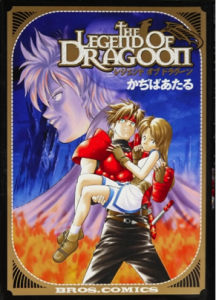
BONUS LEVEL: That is Not…Your Concern.
I had raved earlier about the opening sequence to this game, but failed to mention the actual opening cinematic because I wanted to discuss it here. The pre-rendered cutscene that begins this story is perhaps one of the best openings in any RPG I have ever encountered, even rivaling the opening to Final Fantasy VII, which I discussed in the Bonus Level section of that article.
It is simply fantastic.
We fade in on the town of Seles being bombarded with flaming projectiles as a somber piano melody plays underneath. Shots of statues in the church’s courtyard look on solemnly as the projectiles destroy people’s homes left and right. We see the townsfolk running for their lives, the elderly stopping to endanger themselves in order to save children who are unable to run on their own.
As the bombardment continues, a general in strange armor walks menacingly towards an unconscious girl lying on the ground. He turns to one of his subordinates, asking “Is this her?” When he is given a nod, he produces a small jewel from his pocket. Placing his hand under the girl’s head, he positions the jewel over her forehead, raising it to the gigantic moon that looms overhead in the night sky. Suddenly, a brilliant light shines down from the moon through the jewel and onto the girl’s forehead. The general places the jewel back into his cloak, mutters, “Indeed,” and retreats back to his horse.
As the general approaches his horse, a man in a dark cloak walks towards him. The general asks this mysterious man just who the girl is, and what exactly they want with her. The cloaked figure responds that that is none of his concern, and reminds him to simply follow the orders he was given. The figure departs, and the general orders his men to ride away from the now-destroyed town of Seles, with the mysterious girl in tow.
Not only is this scene visually striking with perhaps the best track in the entire game, “Ruined Seles” perfectly setting the mood, but it also introduces us to this world of fantasy in a way that gives us just enough insight into the way that it works. We see the power and cruelty of the empire as they destroy a defenseless city, and yet we also see through the general’s hesitance that the power of the empire isn’t necessary absolute: even the people in the army have questions about its mysterious dealings. We are told that Shana, the girl, is important to the empire, and the mysteriousness of the hooded figure alludes to the a much grander story behind it all. This cinematic, coupled with the opening sequence that introduces Rose and Dart, is undeniably the most memorable part of The Legend of Dragoon.
VERDICT: If Only It Were a Series…
This was a difficult choice for me, because The Legend of Dragoon is truly one of my favorite games of all time—one that I sunk more than a few weekends into when I was in elementary school. The gameplay, visuals, and music are some of the most memorable that the world of PlayStation-era JRPGs had to offer, but the story is so sprawling and ambitious that it cannot help but lose the player in its complexity.
I truly believe this game would have been better as a series, with some of the more complicated story beats being given a bit more time to breathe. Had the entire game been treated with the same finesse and brilliant pacing that the opening sequence had, there is no doubt in my mind that The Legend of Dragoon would have continued into the 21st century as a long-running, beloved, and brilliant series of role-playing games. But, as it stands, this game ends up in that unforgiving no-man’s land between having a lot of interesting things to offer and just not quite making it into the canon.
Sorry, The Legend of Dragoon. You may not be in the canon, but we sure hope to see you again.
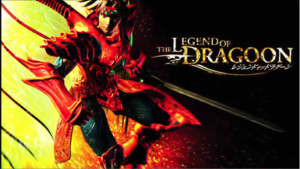
Shine on, you crazy Dragoon!




4 Comments
Mary · September 22, 2017 at 8:47 pm
I remember when a demo of this game was available in Target. The graphics back then looked as hyper realistic to me as modern-day graphics do now, and seeing the game again knowing what games look like now is surreal for me.
Jacen · February 15, 2018 at 9:01 pm
Wow, this is wrong on so many levels I don’t even know where to start…. Maybe you should have replayed the game before trying to review it, because you got so many basic story facts incorrect it’s not even funny.
For instance, Lloyd doesn’t die in disc one, in fact he doesn’t die until just before the final battle. And Zieg isn’t an eternal emperor he was petrified by Melbu Frahma (not sure what’s so inexplicable about his name) for 11,000 years. Anyway you get the point.
Besides if your going to study something in depth, than you should at least give examples of what your talking about. Like how early are lore drops interjected? instead of just saying they are. All in all this shows a severe lack of research and/or understanding.
Dan Hughes · February 23, 2018 at 7:34 am
Hey Jacen,
First of all, thanks for reading. I’m sorry that you have some issues with my piece on “The Legend of Dragoon,” so I just wanted to take a few moments here to address some of your problems and try to make my overall point a bit clearer.
On the subject of story facts, I will admit that I made a small error in saying that Lloyd dies in disc one. I think that while I was writing this, I conflated Lloyd and Lavitz and for some reason believed that they both died either at the end of disc one or thereabouts. In that name error, I beg your pardon, and will be editing that to excise the error. As for Zieg/Diaz not being an “eternal” emperor, I would say that that’s a largely semantic argument due to Zieg and Rose’s connection to the Virage Embryo, Melbu Frahma, and all the Wingly/Dragoon conflict that dates back ages in the world of the story. Granted, there is nowhere in the text where the world “eternal” is used, so I will edit that as well.
Apart from those two concerns, I’m afraid I don’t see other points in the article in which I say anything that doesn’t happen in the game’s story. I freely admit that I make fun of some of the fantasy terms and the villain’s name, but that’s more of a subjective, jokey criticism than getting the story wrong. And when it comes to my criticism about dropping too much lore in too quickly, I outline that in a scene that I actually really like in the “Bonus Level” section above. The opening scene of “Dragoon” is an amazing cinematic experience that sets the tone for the rest of the game, AND it throws out some names, some weird visual concepts, and some elements that are not really fleshed out until far later in the story.
My biggest point of contention with this game is that it presents too large a world and doesn’t quite rein it in enough to tell a concise, meaningful story. I glean from your comment that you are a huge fan of the game, and I hope that in reading this article you understand that I am as well. However, the point of this series that I am writing is to take off the nostalgia goggles and look at a game as an insular product, and in my opinion the fantasy presented by “The Legend of Dragoon” is too sprawling and ambitious without appropriate payoff. You’ll notice later in the article I compare it to “Final Fantasy VII,” which has an equally sprawling story and world but is grounded in a well-written, heavily focused on and explored theme that this game does not have.
I fully appreciate nostalgia for this game, because I have a great deal of it myself. I think the cinematography and music are incredible, and I mention in the article that it has some maybe the most nuanced battle system of any RPG I have ever played, but when it comes to the story it is just too all over the place.
I hope I’ve addressed some of your concerns, and thank you for reading.
Cheers,
Dan H.
Dave · January 12, 2022 at 4:10 pm
Hey, Dan. Thanks for writing up such a thorough review of what is easily one of my favorite games. You offered some valid critiques and really got me thinking more deeply about aspects of design I hadn’t considered. On a nitpicky note, I think there’s still a point where you mistakenly refer to Lloyd as Lavitz.